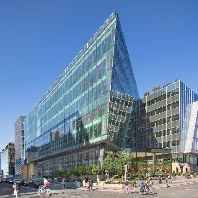The European real estate markets have put the worst behind them and are showing broad signs of recovery. This is the core statement from the property barometer of IVG Immobilien AG and Cushman & Wakefield Healey & Baker for the first quarter of 2005.
"The recovery of the European real estate markets which we predicted in the last quarter is continuing: the upwards trend in the rental volume continues and rents are also rising in many European cities", says Bernd Kottmann, Member of the Board of Management for portfolio management at IVG Immobilien AG.
It should be stressed in particular that the sales of space in most German cities have increased by over 10% in comparison with the same period in the previous year. âThe German office market may still lag behind development in Europe, but the light can clearly be seen at the end of the tunnelâ, according to Kottmann.
In the opinion of the European property company IVG, despite the drastic downwards adjustment of growth figures, Germany offers some interesting opportunities for investors. Recent commitments from Angle-Saxon investors, who often play a pioneering role, impressively demonstrate faith in Europeâs largest property market.
Pleasingly high rental volume
Rental turnover increased by 6% in the 21 significant European office market locations between the first quarter of 2004 and the end of March 2005. 1.8 million m² were rented in the first three months of the year alone. 1.6 million m² of this were in West European cities â" an increase of 3.9% - 0.2 million m² were in the Central European cities of Budapest, Prague and Warsaw.
The long maligned German cities in particular posted clear rental increases in comparison with the weak first quarter of 2004: in Berlin, 105,000 m² had been rented by the end of March, an increase of 75% in comparison with the first quarter of 2004 and in Frankfurt the figure was 95,500 m2 (+71%). The greatest slumps were in Rome and Lisbon. The largest number of m² rented was in Paris, with 368,500.
Rental activities also varied in Central Europe: Budapest up by 22% (66,100 m²), Prague down by 13% (31,800 m2) and Warsaw stable (106,400 m²).
Vacancy rate stable
There was no noteworthy change in the vacancy rate in the first quarter. In the average of the 21 office markets examined, it is unchanged at almost 10%. In Western Europe, 9.5% of all office space is empty. In the three Central European cities, it is 13.4%. However, here, the vacancy rate decreased by 2.2 percentage points or 15% within a year. The sharpest decrease was in Budapest which went from 18.9% in the first quarter to 15.2% at the end of the year and is now only 14%.
The highest vacancy rate is in Amsterdam, with 20% of all spaces and Stockholm with 19%. The lowest vacancy rate is in Paris and Vienna with approximately 6.3%. This explains the attractiveness of the French capital. âFor IVG, Paris is one of the most important target markets, along with London and Brusselsâ, says Kottmann. In German office cities, the vacancy rate ranges from 8% in Hamburg to 17% in Frankfurt. Despite increasing sales of space, the vacancy rate in Frankfurt did not decrease in comparison with the turn of the year. It did, however, remain steady.
Top rents increased
The highest rents are increasing in more and more office locations. This reveals how interested companies are in modern spaces in prestigious buildings in the best inner-city locations. Within a year, the top rent in Western Europe has increased by 4% to almost â¬46. In Eastern Europe, on the other hand, it has decreased slightly by 0.7% to almost â¬18.
The highest price increase was in London, which has the most expensive offices: the top rent increased by 11% to â¬104 since the first quarter of 2004; and even in comparison with the already high level at the end of 2004, a further increase of 3% was posted. Paris continues to be the location where the second highest rent of â¬52 is being paid. In Germany, the highest rents remained steady at â¬28 i







